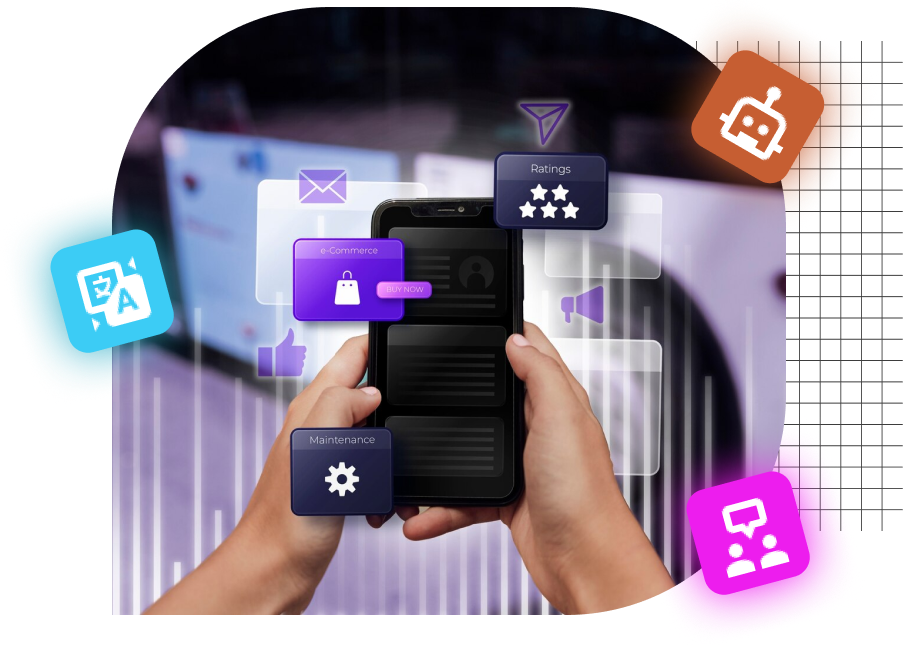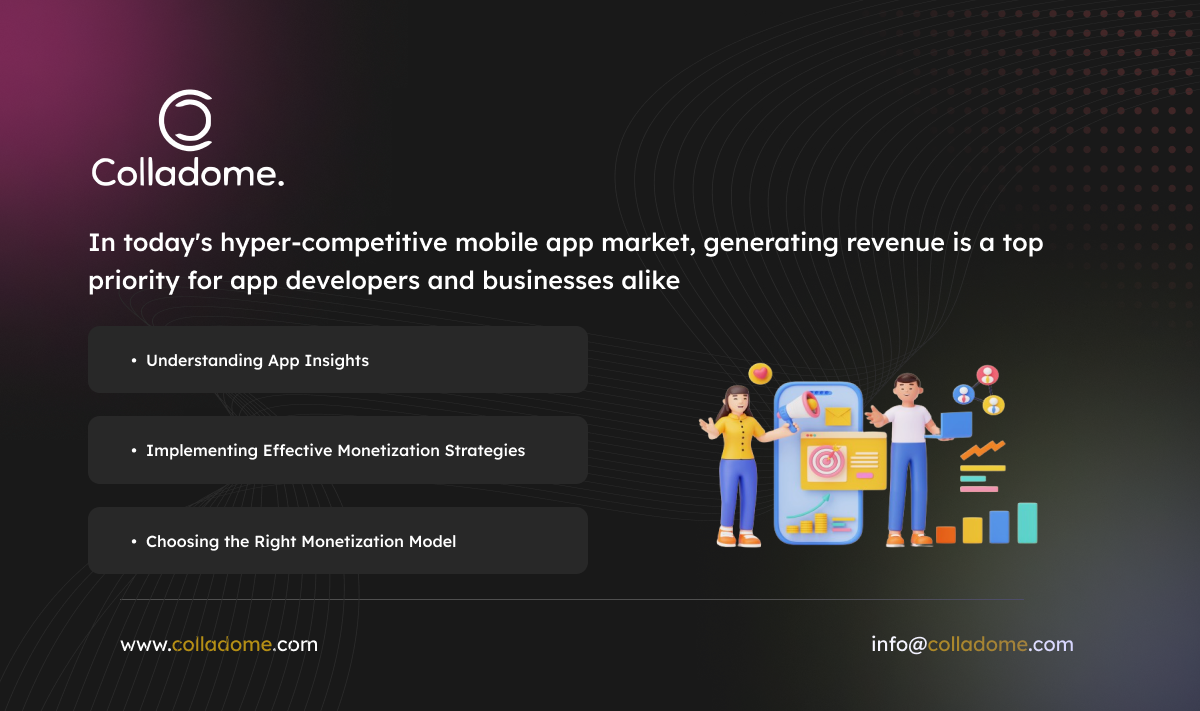In today’s hyper-competitive mobile app market, generating revenue is a top priority for app developers and businesses alike. Implementing effective monetization strategies is essential to maximize revenue and ensure long-term success amid intense app competition. In this blog post, we’ll explore various monetization strategies for mobile apps and provide examples of successful implementations.
Understanding App Insights
Before Understanding app insights, such as user behaviors and engagement metrics, is crucial before diving into monetization strategies. Finally Leveraging app analytics tools can provide valuable insights into user demographics, retention rates, in-mobile apps purchases, and more. By analyzing this data, developers can tailor their monetization strategies to better align with user needs and preferences.
User Behavior Analysis:
- Feature Utilization: Identify which features users engage with the most and which ones are underutilized. This insight can help prioritize feature improvements or enhancements that align with user preferences.
- User Journeys: During Analyze user paths within the app to understand common workflows and potential points of friction. By optimizing these journeys, developers can improve user satisfaction and encourage deeper engagement.
- Drop-off Points: Identify areas where users tend to drop off or abandon the mobile apps. Understanding these pain points can help optimize user experiences and reduce churn rates.
Preference Identification:
- Content Personalization: Utilize user data to personalize content recommendations, notifications, and offers based on individual preferences and behaviors. Personalization can enhance user engagement and increase the likelihood of conversion.
- Customization Options: Provide users with options to customize their app experience, such as themes, settings, or content preferences. Empowering users to tailor the mobile app to their preferences can enhance satisfaction and retention.
Engagement Metrics Evaluation:
-
- Session Duration: Further Analyze how long users spend within the app during each session. Longer session durations typically indicate higher engagement levels and a deeper connection with the mobile apps.
- Frequency of Use: Track how often users return to the app over time. High-frequency users are more likely to be loyal and engaged, making them prime targets for monetization efforts.
- Retention Rates: Monitor retention rates to assess user loyalty and the effectiveness of retention strategies. Understanding why users churn can inform improvements to retention efforts and overall app experience.
Demographic Insights:
- User Segmentation: furtherSegment users based on demographics such as age, gender, location, or device type to better understand their unique needs and preferences. Tailor marketing messages and monetization strategies to resonate with each segment.
- Targeted Advertising: Use demographic insights to deliver targeted advertising campaigns that are relevant to specific audience segments. This approach can increase the effectiveness of ad monetization efforts and maximize revenue potential.
In-Depth Data Analysis:
-
- In-App Purchases Analysis: Analyze data on in-mobile apps purchases to identify trends, popular items, and purchasing behaviors. Use this insight to optimize pricing strategies, promote high-demand items, and incentivize repeat purchases.
- Subscription Rates: Evaluate subscription conversion rates, churn rates, and retention metrics to optimize subscription-based monetization models. Experiment with pricing tiers, trial periods, and value-added benefits to maximize subscription revenue.
- Ad Engagement Metrics: Monitor ad engagement metrics such as click-through rates, viewability, and conversion rates to optimize ad placements and formats. Experiment with different ad networks, placements, and targeting strategies to maximize ad revenue while maintaining a positive user experience.
Choosing the Right Monetization Model
Similarly Mobile applications have revolutionized the way we interact with technology, offering solutions to our needs at the tap of a screen. However, in today’s crowded mobile apps market, developers face the challenge of not only creating compelling apps but also monetizing them effectively. This is where in-mobile apps monetization models come into play, offering developers various strategies to generate revenue directly from their apps.
In this article, we’ll explore the key in-app monetization models, from freemium to subscriptions, advertising to paywalls. By understanding these models and their implementation strategies, developers can unlock new revenue streams and maximize profitability in a competitive market. Let’s dive in and discover how to leverage in-app monetization to drive success in the dynamic world of mobile apps.
-
Freemium Model:
The freemium model offers users a basic version of the app for free, while additional premium features or content are available for purchase.
Implementation: Developers can strategically offer limited access to certain features, levels, or content within the app, enticing users to upgrade to the premium version for a fee. This model relies on upselling and providing value-added features to incentivize users to make in-app purchases.
Example: Gaming apps often employ the freemium model by offering free gameplay with the option to purchase virtual currency, power-ups, or additional levels for enhanced gameplay experience.
-
In-App Advertising:
In-app advertising involves displaying third-party advertisements within the app interface, generating revenue through clicks, impressions, or video views.
Implementation: Developers can integrate various ad formats, such as banners, interstitials, native ads, or rewarded videos, into their app’s interface. Ad placement should be strategic to maximize visibility without compromising user experience.
Example: Social networking apps often incorporate native ads seamlessly into users’ feeds, while gaming apps may offer users the option to watch rewarded videos in exchange for in-game rewards.
-
In-App Purchases (IAP):
In-app purchases allow users to buy virtual goods, upgrades, or additional content directly within the app.
Implementation: Developers can offer a range of virtual items, such as digital goods, power-ups, premium content, or subscription services, for purchase within the app. These purchases can enhance user experience, progression, or customization options.
Example: Productivity apps may offer premium features, such as advanced task management or cloud storage integration, through in-app purchases, while photo editing apps may provide additional filters or editing tools for purchase.
-
Subscription Model:
The subscription model offers users access to premium content or services on a recurring basis in exchange for a subscription fee.
Implementation: Developers can offer subscription plans with different tiers or durations, providing users with exclusive features, content, or benefits. Subscription-based apps often offer free trials to entice users to subscribe and retain them through ongoing value.
Example: Streaming services like Netflix or Spotify offer subscription plans for access to ad-free content, offline playback, and exclusive features.
-
Paywalls or Unlockable Content:
This model involves restricting access to certain features or content within the app until users make a one-time purchase to unlock it.
Implementation: Developers can offer gated content, advanced functionality, or premium features that users can unlock through a one-time payment. This approach encourages users to invest in the app to access additional value.
Example: Generally Education apps may offer free access to basic lessons or modules, with premium content locked behind a paywall for users to unlock.
-
Sponsorships and Partnerships:
Developers can monetize their apps through sponsorships, brand partnerships, or collaborations with other businesses to promote products or services within the app.
Implementation: Developers can integrate sponsored content, branded experiences, or promotional offers within the app’s interface, generating revenue through sponsored placements or affiliate marketing arrangements.
Example: Fitness apps may partner with sports apparel brands to offer exclusive discounts or promotions to users, while travel apps may feature sponsored recommendations for hotels or activities.

Implementing Effective Monetization Strategies
Regardless of the chosen monetization model, there are several key strategies that developers can implement to maximize revenue:
-
User-Centric Design:
-
- Enhanced User Experience: Prioritize user experience (UX) by ensuring that monetization methods seamlessly integrate into the app’s interface and workflow. Design non-intrusive ad formats that align with the app’s aesthetic and functionality.
- Relevant and Targeted Advertising: Rather than bombarding users with irrelevant ads, it is more effective to focus on delivering targeted advertising that aligns with their interests and preferences.
- Opt-Out Options: Provide users with options to control their ad experience, such as the ability to opt out of certain ad categories or personalize their ad preferences. Moreover, Respecting user choice enhances trust and reduces the likelihood of churn due to ad fatigue.
-
Experimentation and Optimization:
-
- Continuous Testing: Embrace a culture of experimentation by regularly testing different monetization strategies, pricing models, and ad formats. In addition, utilize A/B testing, multivariate testing, and cohort analysis to assess the impact of changes on key metrics such as revenue per user (RPU) and customer lifetime value (CLV).
- Data-Driven Insights: Base decisions on empirical data rather than assumptions or intuition. Analyze performance metrics, user feedback, and market trends to identify opportunities for optimization and refinement.
- Iterative Improvement: Additionally, iterate on monetization strategies based on insights gained from experimentation and optimization efforts. Moreover, implement incremental changes and monitor their impact over time, refining strategies to maximize revenue while maintaining a positive user experience.
Offering Value-Added Services:
-
- Premium Features: Generally Identify features or functionalities that provide significant value to users and reserve them for premium versions of the app. Highlight these premium features through in-app promotions, demos, or trial periods to showcase their benefits and encourage upgrades.
- Exclusive Content: Overall Create exclusive content or services that are only accessible to paying subscribers or premium users. This could include bonus levels in a gaming app, ad-free streaming in a media app, or advanced analytics in a productivity tool.
- Personalized Experiences: Tailor the app experience to individual users’ preferences and behaviors to enhance perceived value. Use data-driven personalization techniques to recommend relevant content, customize user interfaces, and deliver personalized notifications or offers that resonate with each user.
- Premium Features: Generally Identify features or functionalities that provide significant value to users and reserve them for premium versions of the app. Highlight these premium features through in-app promotions, demos, or trial periods to showcase their benefits and encourage upgrades.
-
Engagement and Retention:
-
- Regular Updates and New Features: Keep users engaged and excited about your app by regularly releasing updates, introducing new features, and addressing user feedback. Continuous improvement fosters a sense of loyalty and encourages users to remain active within the app.
- Loyalty Programs and Rewards: Implement loyalty programs, reward schemes, or gamification elements to incentivize user engagement and retention. Offer rewards for frequent usage, referrals, or in-app achievements to foster a sense of value and community among users.
-
Community Building:
-
- User Feedback and Communication: Basically Gather feedback from users via surveys, ratings, and reviews, and promptly address inquiries. Engage with users on social media or forums to build trust and connection.
- User-Generated Content: Encourage users to create and share content related to your app, such as reviews, testimonials, or user-generated challenges. User-generated content not only promotes engagement but also serves as authentic social proof for prospective users.
Conclusion
Therefore, Understanding app insights and effective monetization strategies are vital for success in the competitive mobile app market. By leveraging analytics to gain insights on user behaviors and preferences, developers can improve their monetization strategies to boost revenue.
Moreover, by diversifying revenue streams, developers can better safeguard against market fluctuations. Ultimately, this approach can lead to sustained growth and a stronger position in the competitive landscape.
Furthermore, developers need to carefully choose the best monetization model for their app, based on the target audience, content, and value proposition. By aligning strategies with user preferences and creating value-added experiences, they can establish sustainable revenue streams and loyal communities.
Ultimately, Developers can achieve success in the mobile app market by iteratively optimizing strategies based on insights and feedback to drive effective monetization.





















































